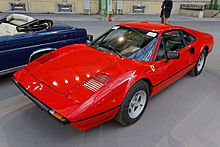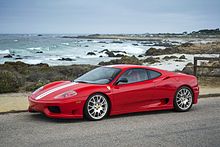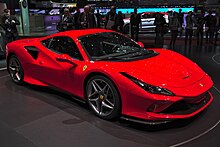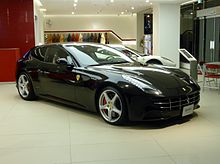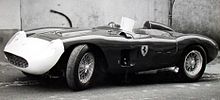Ferrari
| Ferrari NV
|
|
|---|---|
| legal form | Corporation |
| ISIN | NL0011585146 |
| founding | 1947 |
| Seat |
|
| management | |
| Number of employees | 4,285 |
| sales | EUR 3.76 billion |
| Branch | Automotive industry |
| Website | www.ferrari.com |
| As of December 31, 2019 | |
Ferrari is an Italian automobile manufacturer of sports cars and Formula 1 vehicles with legal headquarters in Amsterdam and administrative headquarters in Maranello in the Italian province of Modena . The company was founded in 1947 by the former racing driver Enzo Ferrari and until 2016 belonged to Fiat Chrysler Automobiles with around 80 percent .
Ferrari went public on the New York Stock Exchange on October 21, 2015 through the sale of nine percent of the shares in the main shareholder Fiat Chrysler Automobiles . The remaining shares were distributed to the shareholders of Fiat Chrysler Automobiles at the end of January 3, 2016 in the form of a spin-off. The next day the Ferrari share was listed as a secondary listing on the Milan stock exchange. Today it is listed in the leading index FTSE MIB .
The German branch is located in Wiesbaden , which is also responsible for business in Central and Eastern Europe .
history


The origins of the company go back to the Scuderia Ferrari racing team , which from 1929 to 1938 under the direction of Enzo Ferrari, among others as a works team for Alfa Romeo , drove very successfully car races without building any vehicles. The logo that is still used today was already in use at that time: a rearing horse, the cavallino rampante .
In 1940 the Scuderia was renamed "Auto Avio Costruzioni Ferrari" and in 1943 it moved to Maranello, where it still has its headquarters today. The factory was bombed in 1944 and rebuilt in 1946.
The first “real” Ferrari was the Ferrari 125 C Sport built in 1947 with a 1.5-liter V12 engine. Back then, Ferrari primarily built racing cars for sports car races like the Mille Miglia , which were also sold to customers in order to earn money.
This resulted in road cars that were not suitable for racing. Known for exceptional styling from the Pininfarina company , Ferrari cars are and were popular with the 'rich and famous'. In addition to Pininfarina, Scaglietti , Bertone and Vignale were also commissioned to design Ferraris.
Ferrari was often in crises. As early as the 1960s, Ford made a takeover offer that was rejected, whereupon the Ford GT40 Ferrari broke previous dominance in sports car races. Fiat's entry in 1969 with 50 percent provided the finances for an expensive answer to the Porsche 917 by building 25 copies of the Ferrari 512S , but it wasn't until 1972/73 that the sports cars were victorious again. After that, Ferrari stopped this type of racing, especially since the F1 team was desolate in 1973 and had to suspend some races.
In the USA, safety, consumption and emissions regulations from the 1970s onwards had practically "castrated" sports cars and caused sales to collapse. It was not until the death of the founder Enzo Ferrari in 1988 that there was a boom in demand, especially for classics, including the evocation of the Ferrari myth , as some could not imagine that Ferraris could continue to be made without Enzo Ferrari. With the successes in Formula 1, the brand finally got the upper hand again from 1996.
For sporty amateurs, however, Ferrari had hardly any suitable cars on offer since the mid-1960s. Only recently have racing versions of the V8 models ( Ferrari 360 ) been developed, with which customer teams could not only face the competition in endurance races in the Ferrari one-make cup .
On November 4, 2010, a 25 hectare theme park dedicated to fast driving was opened under the name Ferrari World in Abu Dhabi in the emirate of the same name . It is primarily used by Ferrari friends and potential customers in the Middle East to get in the mood for the sports car brand.
On October 29, 2014, the newly formed Fiat Chrysler Automobiles (FCA) announced that it would sell its 90 percent stake in Ferrari in 2015. Ten percent of the shares were to be listed on the stock exchange and the remaining 80 percent to be issued to FCA shareholders. These can then also be sold on the stock exchange after the Ferrari IPO. Enzo Ferrari's son Piero Ferrari still holds ten percent of Ferrari .
In the course of the Covid-19 pandemic in 2020, Ferrari manufactured individual parts for ventilators .
The Cavallino rampante (German rearing horse)
The brand's emblem is a black horse on a yellow background, with the letters SF for "Scuderia Ferrari" (German: Ferrari racing team). The horse was originally the symbol of Baron Francesco Baracca , a flying ace of the Aeronautica Militare in the First World War . Baron Baracca was shot down on June 19, 1918 after 34 victorious aerial battles and quickly became a national hero. He had the horse painted on the planes of his flight group because it was in the coat of arms of the Piemonte Cavalleria cavalry regiment , to which he had belonged. The military unit in which Enzo Ferrari's brother, Dino, fought and fell in World War I, also had the jumping horse in its coat of arms. Another unproven theory is that Baracca copied the horse from a German pilot who wore the very similar coat of arms of the city of Stuttgart on his plane. The German automobile manufacturer Porsche has also integrated the city coat of arms of its Stuttgart-Zuffenhausen location into its trademark.
In 1923 Enzo Ferrari won a car race in Ravenna and met the Contessa Paolina Biancoli, Baracca's mother. From her he received the suggestion to use the horse as an emblem. However, the logo was only allowed to be used on the Alfa Romeos used by Scuderia Ferrari after the race in Spa-Francorchamps in 1932 .
The yellow background was added by Enzo Ferrari because it was the color of his hometown Modena , where the company was then based. However, it is also often claimed that Enzo Ferrari used the color because of his predilection for sunflowers.
By the way, the horse doesn't just represent Ferrari. Fabio Taglioni's company Ducati also used it for their motorcycles. Taglioni's father was a friend of Baron Baracca's and flew in his group, the 91ª Squadriglia des 4º Stormo . After Ferrari became famous, the horse disappeared as a logo for Ducati, and it is believed that the two companies entered into an agreement to use it.
Today the horse is a registered trademark for Ferrari.
The petrol station chain Avanti uses an almost identical logo with black and yellow colors in Austria and Eastern Europe.
The Swedish guitarist and Ferrari fan Yngwie Malmsteen named the second movement of his Concerto Suite for Electric Guitar after the Ferrari coat of arms Cavallino rampante .
Models
nomenclature
Many types of both racing cars and road cars have a number in their name that can be deciphered in different ways.
Up until the “dinosaur” era, it generally referred to the rounded cubic capacity of a single cylinder. If you multiply the individual cubic capacity of a cylinder by the number of cylinders, you get the total cubic capacity. Examples: 275 (V12) then means 12 × 275 cm³ = 3.3 l; 625 (four-cylinder in-line engine), on the other hand, 4 × 625 cm³ = 2.5 l.
In the V6 and V8 mid-engined Ferraris from the 1970s onwards, this was abandoned and the rounded total displacement in deciliters was placed in the first two digits and the number of cylinders in the last. Dino 246 can be read as: displacement 2.4 l, 6 cylinders; Ferrari 308, 328 or 348 is accordingly an eight-cylinder with 3.0, 3.2 or 3.4 l displacement.
In the case of 12-cylinder flat engines with a 180 ° cylinder bank angle, the first digit indicated the rounded displacement in liters, while the last two indicated the number of cylinders. Example: Ferrari 512 = 5 liter displacement from 12 cylinders. The 365 GT4 BB was an exception - the single displacement of a cylinder was used here, although it was a vehicle with a flat engine.
The Ferrari 355 represents an exception and transition to the new nomenclature: 3.5 l with 5 valves. The models after that (360, 430, 550, 575, 599) directly indicate the displacement: 3.6 to 5.99 l.
The Ferrari 458 Italia apparently follows the rule of total displacement in the first two places, the number of cylinders in the last - it has (just under) 4.5 liters displacement and eight cylinders.
Timeline
| Timeline of the Ferrari and Dino production models from 1967 to today | ||||||||||||||||||||||||||||||||||||||||||||||||||||||||
|---|---|---|---|---|---|---|---|---|---|---|---|---|---|---|---|---|---|---|---|---|---|---|---|---|---|---|---|---|---|---|---|---|---|---|---|---|---|---|---|---|---|---|---|---|---|---|---|---|---|---|---|---|---|---|---|---|
| Type / engine | 60s | 70s | 80s | 90s | 2000s | 2010s | 2020s | |||||||||||||||||||||||||||||||||||||||||||||||||
| 7th | 8th | 9 | 0 | 1 | 2 | 3 | 4th | 5 | 6th | 7th | 8th | 9 | 0 | 1 | 2 | 3 | 4th | 5 | 6th | 7th | 8th | 9 | 0 | 1 | 2 | 3 | 4th | 5 | 6th | 7th | 8th | 9 | 0 | 1 | 2 | 3 | 4th | 5 | 6th | 7th | 8th | 9 | 0 | 1 | 2 | 3 | 4th | 5 | 6th | 7th | 8th | 9 | 0 | 1 | ||
| Sports car with mid-engine | V6 | 206 | 246 | |||||||||||||||||||||||||||||||||||||||||||||||||||||
| V8 | 208 GT4 | 208 | 208 turbo | 208 turbo | ||||||||||||||||||||||||||||||||||||||||||||||||||||
| 308 | 328 | 348 | F355 | 360 | F430 | 458 | 488 | F8 | ||||||||||||||||||||||||||||||||||||||||||||||||
| V8 4 seater | 308 GT4 | Mondial 8 | Mondial QV | Mondial 3.2 | Mondial t | Roma | ||||||||||||||||||||||||||||||||||||||||||||||||||
| V12 | 365 GT / 4 BB | 512 BB | 512 BBi | Testarossa | 512 TR | F512 M | ||||||||||||||||||||||||||||||||||||||||||||||||||
| Sports car with a front engine | V8 | California | Portofino | |||||||||||||||||||||||||||||||||||||||||||||||||||||
| V12 | 330 GTC | 365 GTC | 365 GTB / 4 | 550 | 575 | 599 | F12berlinetta | 812 | ||||||||||||||||||||||||||||||||||||||||||||||||
| Monza SP | ||||||||||||||||||||||||||||||||||||||||||||||||||||||||
| V12 4 seater | 365 GT | 365 GTC / 4th | 365 GT4 | 400 GT | 400i | 412 | 456 GT | 456 M. | 612 Scaglietti | FF | GTC4Lusso | |||||||||||||||||||||||||||||||||||||||||||||
| Supercar | V8 | 288 GTO | F40 | SF90 | ||||||||||||||||||||||||||||||||||||||||||||||||||||
| V12 | F50 | Enzo Ferrari | LaFerrari | |||||||||||||||||||||||||||||||||||||||||||||||||||||
| race car | F40 LM | FXX | FXX K | |||||||||||||||||||||||||||||||||||||||||||||||||||||
|
|
||||||||||||||||||||||||||||||||||||||||||||||||||||||||
Six- and eight-cylinder
Six-cylinder:
- Ferrari Dino 206 GT (1967-1969)
- Ferrari Dino 246 GT / GTS (1969–1974)
- Ferrari 296 GTB (from 2022)
Eight-cylinder:
- Ferrari Dino 308 GT 4 (1973-1980)
- Ferrari Dino 208 GT 4 (1975-1980)
- Ferrari 308/208 GTB / GTS / GTBi / GTSi / Quatrovalvole or turbo (1975–1985)
- Ferrari 328 GTB / GTS (1985-1989)
- Ferrari 348 tb / ts / GTB / GTS / Spider / Speziale / GT Competizione (1989–1995)
- Ferrari F355 Berlinetta / GTS / Spider / F1 Spider Serie Fiorano (1995–1999)
- Ferrari 360 Modena / Spider (1999-2005)
- Ferrari F430 (2004-2009)
- Ferrari California (2008-2017)
- Ferrari 458 Italia (2009-2016)
- Ferrari 488 GTB (2015-2019)
- Ferrari GTC4Lusso T (2016-2020)
- Ferrari Portofino (since 2018)
- Ferrari F8 (since 2019)
- Ferrari Roma (since 2020)
as 2 + 2-seater:
- Ferrari Dino 308 GT 4 (1973-1980)
- Ferrari Mondial 8 / QV / Cabriolet (1980-1993)
Twelve-cylinder
- Ferrari 125 (1947)
- Ferrari 159 (1947)
- Ferrari 166 (1948-1953)
- Ferrari 195 (1950–1951)
- Ferrari 212 (1951-1953)
"American" line:
- Ferrari 340 America (1951)
- Ferrari 342 America (1952)
- Ferrari 375 America (1953-1955)
- Ferrari 410 Superamerica (1955-1959)
- Ferrari 400 Superamerica (1959-1964)
- Ferrari 500 Superfast (1964-1966)
"European" line:
- Ferrari 250 Europa / Europa GT / GT / GT Coupé / GT Spyder California / GT Lusso (1953–1964)
- Ferrari 275 GTB / GTB / 4 (1964–1968)
"Common" line:
- Ferrari 330 GTC / GTS (1966-1968)
- Ferrari 365 California Cabriolet / GTC / GTS / GTB / 4 Daytona / GT / 4 BB (1968-1976)
- Ferrari 512 BB (1976-1984)
- Ferrari Testarossa / 512 TR / F512 M (1984-1996)
- Ferrari 550 Maranello / Barchetta Pininfarina (1996-2001)
- Ferrari 575 M Maranello / Superamerica (2002-2006)
- Ferrari 599 GTB Fiorano (2006-2013)
- Ferrari 599 GTO (2010)
- Ferrari F12berlinetta (2012-2017)
- Ferrari 812 (since 2017)
as 2 + 2-seater:
- Ferrari 250 GTE 2 + 2 (1960–1963)
- Ferrari 330 America (1963)
- Ferrari 330 GT 2 + 2 (1964–1967)
- Ferrari 365 GT 2 + 2 (1967–1971)
- Ferrari 365 GTC / 4 (1971-1973)
- Ferrari 365 GT4 2 + 2 (1972-1976)
- Ferrari 400 GT / i (1976–1985)
- Ferrari 412 (1985-1989)
- Ferrari 456 GT / GTA / M GT / M GTA (1993-2004)
- Ferrari 612 Scaglietti (2004-2010)
- Ferrari FF (2011-2016)
- Ferrari GTC4Lusso (2016-2020)
Supercar
- Ferrari 288 GTO (1984–1986)
- Ferrari F40 (1987-1992)
- Ferrari F50 (1996-1997)
- Ferrari Enzo Ferrari (2002-2004)
- Ferrari FXX (2005-2006)
- Ferrari LaFerrari (2013-2018)
- Ferrai SF90 (since 2020)
Racing car
- AAC 815 (1940)
- Dino 166P / 206P (1966)
- Dino 196S (1959)
- Dino 196SP (1962)
- Dino 206S (1958)
- Dino 206S / 246P (1966/67)
- Dino 246S (1960)
- Dino 246SP (1961)
- Dino 286SP (1962)
- Dino 296S (1958)
- Ferrari 225S (1952)
- Ferrari 248SP (1962)
- Ferrari 250S (1952)
- Ferrari 250MM (1952/53)
- Ferrari 250 Monza (1954)
- Ferrari 250 Testa Rossa (1957-1962)
- Ferrari 250P (1963)
- Ferrari 250LM (1963-1966)
- Ferrari 250S / MM / LM (1952 / 53–1963 / 66)
- Ferrari 250 GTO (1961-1964)
- Ferrari 268SP (1962)
- Ferrari 275S (1950)
- Ferrari 275P (1964)
- Ferrari 290 (1956/57)
- Ferrari FXX K (2015)
- Ferrari 306S (1955)
- Ferrari 312S (1958)
- Ferrari 312P (1969-1970)
- Ferrari 312PB
- Ferrari 315S (1957)
- Ferrari 300TR / LM (1962)
- Ferrari 330 LMB (1963)
- Ferrari 330P (1964-1967)
- Ferrari 333SP
- Ferrari 335S (1957)
- Ferrari 340 Mexico (1953)
- Ferrari 340MM (1953)
- Ferrari 365P (1965/66)
- Ferrari 375MM / 375 Plus (1954)
- Ferrari 376S (1955)
- Ferrari 410 (1955/56)
- Ferrari 446S (1955)
- Ferrari 500 TR (1956)
- Ferrari 512S (1970/71)
- Ferrari 625 (1953/1956)
- Ferrari 735S (1953)
- Ferrari 750 Monza (1954/55)
- Ferrari 860 Monza (1955/56)
One-offs, prototypes and design studies
- 250 GT Zagato 3Z
- 250P5 (1968)
- 360 Barchetta (2000)
- 365 GTC 4 Spyder (1971)
- Ferrari 408 4RM (1987)
- 512 BB
- F50 GT
- F100 (1998)
- FX (1996)
- GG50 (2005)
- 512 S Modulo (1970)
- Myth (1989)
- Pinin (1980)
- PPG Pace Car (1987)
- Rossa (2000)
- SP1 (2008)
- Ferrari SP12 Eric Clapton (2012)
- Superfast I – IV (1956–1962)
- Testa D'Oro Colani (1991)
- Ferrari FXX K (2015-2016)
- Ferrari SP38 (2018)
- Ferrari P80 / C (2019)
Grand Prix and Formula 1 cars
- 125GP (1948/49)
- 125F1 (1949/50)
- 275F1 (1950)
- 375F1 (1950/51)
- 212F1 (1951)
- 500 (1952/53)
- 625F1 (1954/55)
- 553 Squalo (1953/54)
- 555 Super Qualo (1955)
- D50 (1956)
- 801 (1957)
- Dino 246F1 (1957)
- 156 (1961-1964)
- 158 (1964/65)
- 1512 (1964/65)
- 312F1 (1966-1969)
- 246 Tasman (1966)
- 312B / B2 / B3 (1970-1974)
- 312T (1975-1976)
- 312T2 (1976-1978)
- 312T3 (1978-1979)
- 312T4 (1979)
- 312T5 (1980)
- 312T6
- 126CK (1981)
- 126C2 / 126C2B (1982-1983)
- 126C3 (1983)
- 126C4 (1984)
- 156/85 (1985)
- Ferrari F1 / 86 (1986)
- Ferrari F1 / 87 (1987)
- Ferrari F1-87 / 88C (1988)
- 640 (1989)
- 641 (1990)
- 642 (1991)
- 643 (1991)
- F92A / F92AT (1992)
- F93A (1993)
- 412T1 / T1B (1994)
- 412T2 (1995)
- F310 / F310B (1996-1997)
- F300 (1998)
- F399 (1999)
- F1-2000 (2000)
- F2001 / F2001B (2001-2002)
- F2002 (2002-2003)
- F2003-GA (2003)
- F2004 / F2004M (2004-2005)
- F2005 (2005)
- 248 F1 (2006)
- F2007 (2007)
- F2008 (2008)
- F60 (2009)
- F10 (2010)
- 150 ° Italia (2011)
- F2012 (2012)
- F138 (2013)
- F14 T (2014)
- SF15-T (2015)
- SF16-H (2016)
- SF70H (2017)
- SF71H (2018)
- SF90 (2019)
- SF1000 (2020)
- SF21 (2021)
Formula 2 car
- 166F2 (1948-1950)
- Ferrari 500 (1952/53)
- Ferrari 553 Squalo (1953)
- Ferrari Dino 156F2 (1957-1960)
- Ferrari Dino 166 F2 (1967-1970)
Other monopostos
- 166FL (1949/50)
- Ferrari 125F1 Special (1951–1954)
- Ferrari 375 Indianapolis (1952-1954)
- Ferrari 625/750 (1954-1960)
- Ferrari 625 Tasman (1957-1960)
- Ferrari 555/860 (1956/57)
- Ferrari 296MI (1958)
- Ferrari 412MI (1958)
- Dino 246F1 / 250TR (1960–1962)
- Dino 246 Tasman (1969/70)
paragraph

Annual production in 2008 was 6,452 vehicle units. In 2010, 6,500 vehicles were sold, more than ever before. In 2011 this record was set with 7,000 vehicles. 28 percent of the vehicles sold went to the USA. 2019 was the most successful year in Ferrari history with 10,131 vehicles sold.
According to a study by the German economist Ferdinand Dudenhöffer , Ferrari generated (in the first half of 2018) around 69,000 euros in operating profit per vehicle sold. This makes Ferrari the most profitable of all the automobile manufacturers examined.
Homologation
The following models are / were homologated for use in near-series motorsport :
- Ferrari F50 GT as GT2
- Ferrari F430 GTC as GT2
- Ferrari 430 Scuderia GT3 as GT3
- Ferrari 458 Italia GT2 as GT2
- Ferrari 458 Italia GT3 as GT3
- Ferrari 550 GTC as GT
- Ferrari 575 GTC as GT
- Ferrari 360 GTC as N-GT
See also
literature
- Leonardo Acerbi, Luciano Greggio: 60 Years of Ferrari: Moving Moments. Heel, Königswinter 2007, ISBN 978-3898808156 .
- Dennis Adler: Ferrari: The Maranello Myth. Delius Klasing, Bielefeld 2010, ISBN 978-3768831765 .
- Ralph Alex: 70 years of Ferrari (auto motor und sport edition). Presse Stuttgart GmbH & Co, Stuttgart 2017, ISBN 978-3613308442 .
- Keith Bluemel: The Original: Ferrari V12: All front engine models 1965-1973. Heel, Königswinter 2004, ISBN 978-3898802154 .
- Roberto Bonetto: Ferrari: Passion in Red. White Star, Wiesbaden 2011, ISBN 978-3867261814 .
- Roberto Bonetto (ed.): Ferrari: racing and sports cars. Chronology of a success. Motorbuch Verlag, Stuttgart 2004, ISBN 978-3613024595 .
- Matthias Braun, Alexander Franc Storz, Ernst Fischer, Manfred Steinert: Ferrari: road and racing cars since 1946 . Motorbuch Verlag, Stuttgart 2006, ISBN 978-3613026513 .
- Peter Braun, Gregor Schulz: The big Ferrari manual. All series and racing vehicles from 1947 to the present day. Heel, Königswinter 2006, ISBN 978-3898805018 .
- Etienne Cornil: Ferrari by Pininfarina: The Complete Story . German translation by Dorko M. Rybiczka. Heel, Königswinter 2002, ISBN 978-3893658336 .
- Antonio Ghini (Ed.): Ferrari 1947 - 1997. The official book. Heel, Königswinter 1998, ISBN 978-3893657063 .
- Alan Henry: The era of the Ferrari prototypes: 1962 to 1973. Heel, Königswinter 2008, ISBN 978-3868520446 .
- Rüdiger Kaufmann, Jens Fichtner: Ferrari: Series sports car since 1970 (type compass). 1st edition. Motorbuch-Verlag, Stuttgart 2012, ISBN 978-3613034303 .
- Brian Laban: Ferrari: The Story of a Legend. From the 166 MM Barchetta to the F 430 . Motorbuch Verlag, Stuttgart 2005, ISBN 978-3613305359 .
- Hans-Karl Lange: Ferrari: All street sports cars since 1950. Moewig, Rastatt 1990, ISBN 978-3811830554 .
- Pete Lyons: Ferrari. History, types, technology. Heel, Königswinter 1990, ISBN 978-3893652068 .
- Christiane Oppermann: Ferrari: The fastest company in the world. Campus Verlag, Frankfurt am Main 2005, ISBN 978-3593376493 .
- Antoine Prunet, Peter Vann: The Ferrari Myth. Motorbuch Verlag, Stuttgart 1991, ISBN 978-3613012455 .
- Rainer W. Schlegelmilch, Hartmut Lehbrink, Jochen von Osterroth: Ferrari. hfullmann, Potsdam 2016, ISBN 978-3848010974 .
- Gregor Schulz, Thomas Lang: Ferrari Legends. Heel, Königswinter 2008, ISBN 978-3898807104 .
- Ingo Seiff: Ferrari. 2nd Edition. Hoffmann and Campe, Hamburg 1998, ISBN 978-3455082654 .
- Leonildo Turrini (ed.): Ferrari. Best of: The Models - The Drivers - The Victories. Panini Verlags GmbH, Stuttgart 2017, ISBN 978-3-8332-3496-5 .
- Matthias Urban: Manual of Ferrari serial numbers: Ferrari Serial Numbers 1947-2007 (Ferrari World). Heel, Königswinter 2007, ISBN 978-3898807111 .
- Saverio Villa: Ferrari: The legendary models from the Ferrari 166 MM to the Ferrari 458 Speciale. Translation of Arancho Doc. Edizioni White Star SrL, Novara 2014, ISBN 978-8863122312 .
Web links
- Ferrari NV website
- The Scuderia Ferrari Formula 1 site (English)
- Ferrari company history (English)
- Ferrari: Tests and driving reports at auto motor und sport
Individual evidence
- ↑ a b c d e ferrari.com - Ferrari NV 2019 Annual Report
- ↑ ferrari.com - Board of Directors
- ↑ theguardian.com - Ferrari kickstarts split from Fiat Chrysler by filing for NYSE share listing
- ↑ sec.gov - New Business - As filed with the Securities and Exchange Commission on July 23, 2015
- ↑ fcagroup.com - Group Structure
- ↑ finanzen.net - Ferrari IPO: Car maker takes off with IPO
- ↑ ferrari.com - locations
- ↑ ferrari.com - story of Enzo Ferrari (German, English, Italian)
- ↑ ferrari.com - history of the Ferrari company (German, English, Italian)
- ↑ spiegel.de - Sports car manufacturer: Fiat Chrysler wants to bring Ferrari to the stock exchange
- ↑ forbes.com - FCA's Ferrari Move Likely To Make Capital Raising Exercise Run Smoothly
- ↑ Ferrari makes parts to turn snorkel masks into coronavirus kit . In: Reuters . April 16, 2020 ( reuters.com [accessed April 17, 2020]).
- ↑ auto-motor-und-sport.de - sales growth continues
- ↑ Profitability of the car companies: Ferrari earns 69,000 euros per car - Tesla loses 11,000 euros. In: Manager Magazin . August 8, 2018. Retrieved August 8, 2018 .
Coordinates: 44 ° 32 ′ 3 ″ N , 10 ° 51 ′ 28 ″ E


